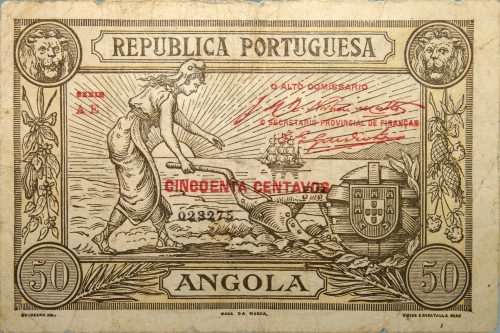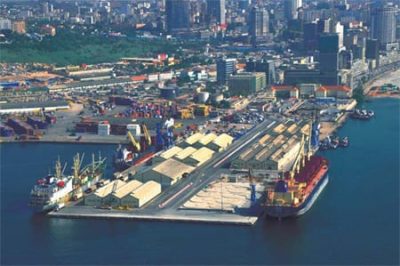P024
Paper, VF
113 mm x 75 mm
HISTORY: Portugal, officially the Portuguese Republic (República Portuguesa), began the colonization of Angola in 1657 when they successfully negotiated a peace agreement with Queen Ana Nzinga (1583‒1663). The Portuguese maintained their control until 1975 when, after protracted conflict, Angola gained its independence. Luanda, the capital of Angola, located on the west coast of Africa, is a natural harbor facing the Atlantic Ocean. It has long been a major port destination.
OBVERSE: This 50-centavos note was created by “QUARESMA,” a Portuguese designer (lower left), engraved by “VIҪOSO & MORATALLA GRAV” (lower right) and printed at the Lisbon, Portugal, mint, “CASA DA MOEDA” (lower center). On the top left and right corners are two lion portraits. Angola has always had a thriving population of lions, notably in the southeast of the country where they are now a protected species. Beneath the lion images are an abundance of hanging fruits and berries, while below the main vignette appears to be sprigs of rosemary with “ANGOLA” framed between.
The vignette seems to be based on the goddess Fortuna, wearing her Phrygian cap, guiding a plough through the pliant loam of earth. She is often considered the fertility deity, associated with the bounty of soil and the fruitfulness of women. Behind her is a westering sunset, a three-masted ship sailing into safe harbor. To the right, in front of the plough, is the Portuguese coat of arms, adopted on June 30, 1911, the wreath slightly askew.
Also worth noting is that the Angola top commissioner and provincial secretary of finance signatures — Series “A E” and “CINCOENTA CENTAVOS” — have been stamped in red ink over the printed image. The serial number has been stamped in black.
REVERSE: This highly filigreed image was the design of an unidentified individual (lower left name is an ink blob) but is exciting nevertheless. The filigree flows around this banknote to the center where, once again, the coat of arms is featured. Below is a rather large winged, cogged wheel. The meaning could represent several traditional ideals, but I’ll go with the cycle of time journeying toward an unknown destiny, from the past, through the present, and into a mysterious future. Below is the date “1921.”
On either side of the wheel are what could be the half-brother Gemini (Dioscuri) twins, casually naked upon the top of a quay wall. Castor, to the left with his cap on, holds a short staff while gazing off to the south. Pollux looks northward, clutching a caduceus (sans serpents) in his left hand. The caduceus is usually associated with Mercury, the Roman deity of commerce. In astrology, however, the planet Mercury (planet of communication), rules the house of Gemini.
Behind the twins are depictions of the Port of Luanda (Porto de Luanda). On Castor’s side are shipping warehouse buildings and rail lines in the southern industrial district of Luanda. An offshore, westerly wind blows the smoke out to sea. Pollux seems to be observing an incoming passenger steamer entering the harbor. Beyond, in the distance, stands the Ilha do Cabo Lighthouse.



